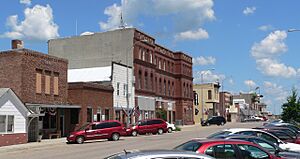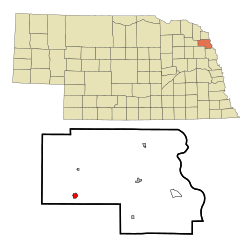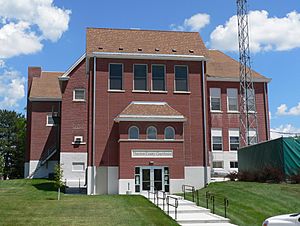Pender, Nebraska facts for kids
Quick facts for kids
Pender, Nebraska
|
|
|---|---|
|
Village
|
|

Downtown Pender: north side of Main Street, July 2010
|
|

Location of Pender, Nebraska
|
|
| Country | United States |
| State | Nebraska |
| County | Thurston |
| Township | Pender |
| Area | |
| • Total | 0.71 sq mi (1.83 km2) |
| • Land | 0.71 sq mi (1.83 km2) |
| • Water | 0.00 sq mi (0.00 km2) |
| Elevation | 1,322 ft (403 m) |
| Population
(2020)
|
|
| • Total | 1,115 |
| • Density | 1,579.32/sq mi (609.61/km2) |
| Time zone | UTC-6 (Central (CST)) |
| • Summer (DST) | UTC-5 (CDT) |
| ZIP code |
68047
|
| Area code(s) | 402 |
| FIPS code | 31-38750 |
| GNIS feature ID | 2399647 |
Pender is a small village in Nebraska, United States. It is the main town, or county seat, of Thurston County. In 2016, the United States Supreme Court, the highest court in the U.S., decided that Pender is located within the boundaries of the Omaha Indian Reservation. In 2020, about 1,115 people lived in Pender.
Contents
History of Pender
People from Europe first settled Pender in April 1885. They named the village after Sir John Pender, a Scottish politician and businessman. Sir John Pender was important because he helped create the first Transatlantic telegraph cable, which allowed messages to be sent across the Atlantic Ocean. He also worked with a railway company.
Understanding Reservation Boundaries
A big topic in Pender is whether the village is inside the Omaha Nation's reservation. The Omaha Nation is a federally recognized Native American tribe. They believe Pender is within their reservation boundaries, based on a treaty they made with the U.S. government in 1865.
However, a Nebraska state court once said that the reservation's western edge was a railroad line east of Pender. This was because the Omaha people had sold land to farmers over many years. The tribe disagreed, saying that a state court cannot change the boundaries set by a U.S. government treaty.
This disagreement about boundaries has led to discussions about who has authority in the area. The Omaha Tribe wanted to set up rules for businesses operating within what they saw as their reservation land.
In 2007, businesses in Pender, along with the village itself, went to a federal court. They argued that Pender was outside the reservation and that the tribe did not have the authority to make these rules. The court asked them to first take their case to the Omaha Tribal Courts. This is a common practice to allow tribal courts to hear cases related to their lands first.
The case continued for several years. Finally, on March 22, 2016, the U.S. Supreme Court made a final decision. All the judges agreed that Pender is indeed within the boundaries of the Omaha Indian Reservation. This decision helped clarify who has authority in the area.
Geography of Pender
Pender is a small village. According to the United States Census Bureau, the village covers about 0.71 square miles (1.83 square kilometers) of land. There is no water area within the village limits.
Population Information
| Historical population | |||
|---|---|---|---|
| Census | Pop. | %± | |
| 1890 | 429 | — | |
| 1900 | 943 | 119.8% | |
| 1910 | 804 | −14.7% | |
| 1920 | 992 | 23.4% | |
| 1930 | 1,006 | 1.4% | |
| 1940 | 1,135 | 12.8% | |
| 1950 | 1,167 | 2.8% | |
| 1960 | 1,165 | −0.2% | |
| 1970 | 1,229 | 5.5% | |
| 1980 | 1,318 | 7.2% | |
| 1990 | 1,208 | −8.3% | |
| 2000 | 1,148 | −5.0% | |
| 2010 | 1,002 | −12.7% | |
| 2020 | 1,115 | 11.3% | |
| U.S. Decennial Census | |||
Pender's Population in 2020
In 2020, the population of Pender was 1,115 people. Most residents were White (92.9%), with smaller numbers of Native American, Black, Asian, and people of other backgrounds. About 3.8% of the population identified as Hispanic or Latino.
Pender's Population in 2010
In 2010, Pender had 1,002 people living in 444 households. Many households (57%) were married couples. About 23.6% of households had children under 18. The average age of people in Pender was about 49.5 years old.
Education in Pender
The local schools in Pender are part of the Pender Public Schools district.
Pender High School is known for its successful girls' basketball teams. The "Pendragons" won the state championship in Class D1 in 2013 and 2024. They also won the Class C2 championship in 2023.
Notable People from Pender
Many interesting people have connections to Pender:
- Marion Broadstone – a professional American football player.
- Monty Budwig – a jazz musician who played the double-bass.
- Dale R. Buis – a U.S. soldier killed during the Vietnam War. His name is the first listed on the Vietnam Veterans Memorial in Washington, D.C.
- Laurie Frink – a world-class American jazz trumpet player.
- Loren Miller – an African-American civil rights lawyer and judge. He was born in Pender.
- Emilio Ochoa – a Cuban dentist and political activist. He taught Spanish at Pender High School for a few years.
- Maurice Pate – a key figure in starting the United Nations Children's Fund (UNICEF).
- Steven M. Reppert – an American neuroscientist who studies how living things keep time and how animals behave.
- Ad Wenke – another professional football player.
See also
 In Spanish: Pender (Nebraska) para niños
In Spanish: Pender (Nebraska) para niños




